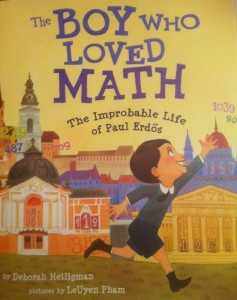Paul Erdős
After reading The Man Who Loved Only Numbers: The Story of Paul Erdős and the Search for Mathematical Truth this summer, I came across a fantastic children’s book about Paul Erdős. The Boy Who Loved Math: The Improbable Life of Paul Erdős by Deborah Heiligman with pictures by LeUyen Pham is an excellent introduction to the man who is well-known for his collaboration in mathematics. Below is a photo of the cover and my favorite illustration in the book:
Below is a short clip from N is a Number, which is a fantastic glimpse of Paul Erdős and his life of collaboration in mathematics:
References:
Heiligman, D. (2013). The boy who loved math: The improbable life of Paul Erdős. New York: Roaring Brook Press.
Hoffman, P. (1998). The man who loved only numbers: The story of Paul Erdős and the search for mathematical truth. New York: Hyperion.


